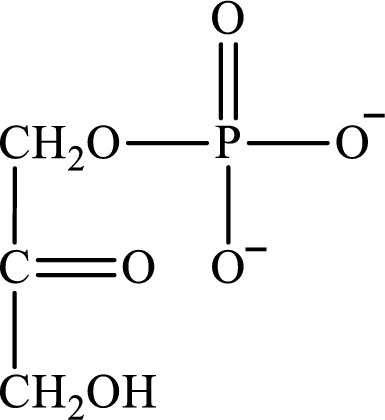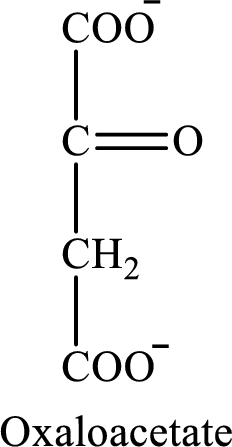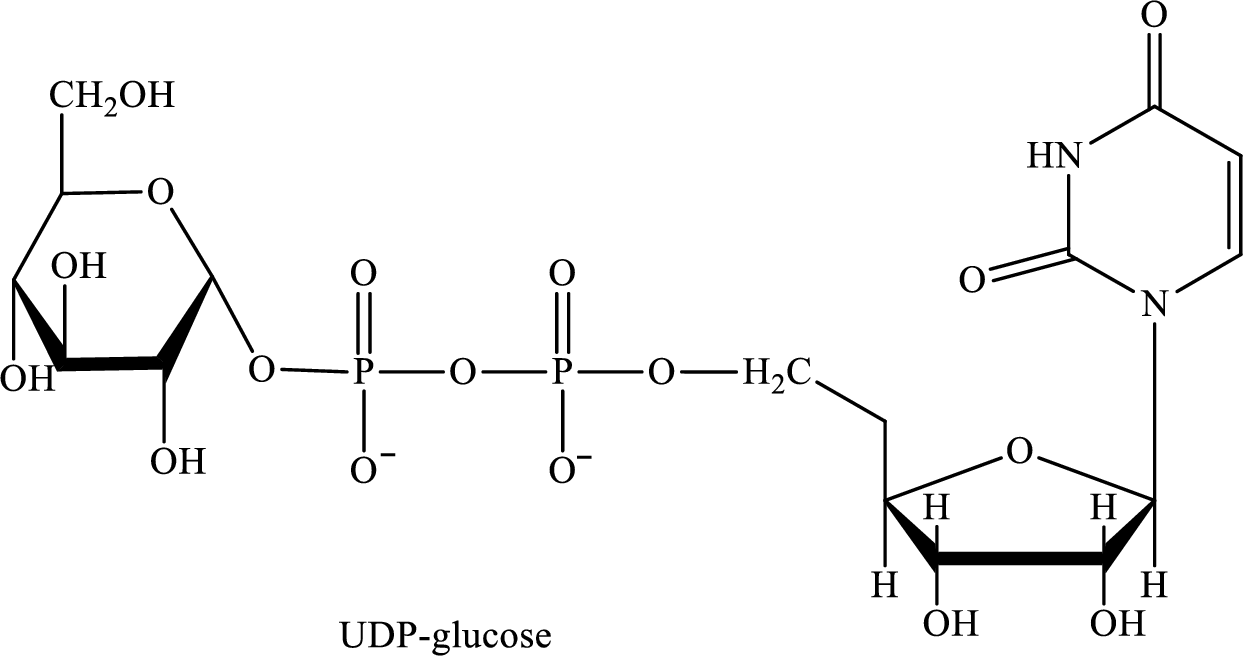
Concept explainers
(a)
Interpretation:
Glucose-6-phosphate is encountered in which of the four processes glycolysis, glycogenesis, glycogenolysis, and gluconeogenesis has to be indicated.
Concept introduction:
In the glycolysis
Gluconeogenesis is an eleven-step pathway in which glucose is produced from non-carbohydrate substances. Glycogenesis is the metabolic pathway that converts glucose-6-phosphate to glycogen. Glycogenolysis is the metabolic pathway that converts glycogen to glucose-6-phosphate.
Glucose-6-phosphate is an activated glucose molecule. The structure of glucose-6-phosphate is as follows:

(b)
Interpretation:
Dihydroxyacetone phosphate is encountered in which of the four processes glycolysis, glycogenesis, glycogenolysis, and gluconeogenesis has to be indicated.
Concept introduction: In the glycolysis metabolic pathway, a glucose molecule breaks down into two pyruvate molecules. Two ATP molecules and NADH reduced coenzymes are produced in the glycolysis pathway.
Gluconeogenesis is an eleven-step pathway in which glucose is produced from non-carbohydrate substances. Glycogenesis is the metabolic pathway that converts glucose-6-phosphate to glycogen. Glycogenolysis is the metabolic pathway that converts glycogen to glucose-6-phosphate.
The structure of dihydroxyacetone phosphate is as follows:

(c)
Interpretation:
Oxaloacetate is encountered in which of the four processes glycolysis, glycogenesis, glycogenolysis, and gluconeogenesis has to be indicated.
Concept introduction:
In the glycolysis metabolic pathway, a glucose molecule breaks down into two pyruvate molecules. Two ATP molecules and NADH reduced coenzymes are produced in the glycolysis pathway.
Gluconeogenesis is an eleven-step pathway in which glucose is produced from non-carbohydrate substances. Glycogenesis is the metabolic pathway that converts glucose-6-phosphate to glycogen. Glycogenolysis is the metabolic pathway that converts glycogen to glucose-6-phosphate.
The structure of oxaloacetate is as follows:

(d)
Interpretation:
UDP-glucose is encountered in which of the four processes glycolysis, glycogenesis, glycogenolysis, and gluconeogenesis has to be indicated.
Concept introduction:
In the glycolysis metabolic pathway, a glucose molecule breaks down into two pyruvate molecules. Two ATP molecules and NADH reduced coenzymes are produced in the glycolysis pathway.
Gluconeogenesis is an eleven-step pathway in which glucose is produced from non-carbohydrate substances. Glycogenesis is the metabolic pathway that converts glucose-6-phosphate to glycogen. Glycogenolysis is the metabolic pathway that converts glycogen to glucose-6-phosphate.
The structure of UDP-glucose is as follows:

Want to see the full answer?
Check out a sample textbook solution
Chapter 24 Solutions
General, Organic, and Biological Chemistry Seventh Edition
- 2. Provide reagents/conditions to accomplish the following syntheses. More than one step is required in some cases. a. CH3arrow_forwardIdentify and provide an explanation that distinguishes a qualitative and quantitative chemical analysis. Provide examples.arrow_forwardIdentify and provide an explanation of the operational principles behind a Atomic Absorption Spectrometer (AAS). List the steps involved.arrow_forward
- Instructions: Complete the questions in the space provided. Show all your work 1. You are trying to determine the rate law expression for a reaction that you are completing at 25°C. You measure the initial reaction rate and the starting concentrations of the reactions for 4 trials. BrO³¯ (aq) + 5Br¯ (aq) + 6H* (aq) → 3Br₂ (l) + 3H2O (l) Initial rate Trial [BrO3] [H*] [Br] (mol/L) (mol/L) | (mol/L) (mol/L.s) 1 0.10 0.10 0.10 8.0 2 0.20 0.10 0.10 16 3 0.10 0.20 0.10 16 4 0.10 0.10 0.20 32 a. Based on the above data what is the rate law expression? b. Solve for the value of k (make sure to include proper units) 2. The proposed reaction mechanism is as follows: i. ii. BrО¸¯ (aq) + H+ (aq) → HBrO3 (aq) HBrO³ (aq) + H* (aq) → H₂BrO3* (aq) iii. H₂BrO³* (aq) + Br¯ (aq) → Br₂O₂ (aq) + H2O (l) [Fast] [Medium] [Slow] iv. Br₂O₂ (aq) + 4H*(aq) + 4Br(aq) → 3Br₂ (l) + H2O (l) [Fast] Evaluate the validity of this proposed reaction. Justify your answer.arrow_forwardе. Д CH3 D*, D20arrow_forwardC. NaOMe, Br Brarrow_forward
- Please predict the products for each of the following reactions: 1.03 2. H₂O NaNH, 1. n-BuLi 2. Mel A H₂ 10 9 0 H2SO4, H₂O HgSO4 Pd or Pt (catalyst) B 9 2 n-BuLi ♡ D2 (deuterium) Lindlar's Catalyst 1. NaNH2 2. EtBr Na, ND3 (deuterium) 2. H₂O2, NaOH 1. (Sia)2BH с Darrow_forwardin the scope of ontario SCH4U grade 12 course, please show ALL workarrow_forwardIs the chemical reaction CuCl42-(green) + 4H2O <==> Cu(H2O)42+(blue) + 4Cl- exothermic or endothermic?arrow_forward
 Chemistry for Today: General, Organic, and Bioche...ChemistryISBN:9781305960060Author:Spencer L. Seager, Michael R. Slabaugh, Maren S. HansenPublisher:Cengage Learning
Chemistry for Today: General, Organic, and Bioche...ChemistryISBN:9781305960060Author:Spencer L. Seager, Michael R. Slabaugh, Maren S. HansenPublisher:Cengage Learning General, Organic, and Biological ChemistryChemistryISBN:9781285853918Author:H. Stephen StokerPublisher:Cengage Learning
General, Organic, and Biological ChemistryChemistryISBN:9781285853918Author:H. Stephen StokerPublisher:Cengage Learning Organic And Biological ChemistryChemistryISBN:9781305081079Author:STOKER, H. Stephen (howard Stephen)Publisher:Cengage Learning,
Organic And Biological ChemistryChemistryISBN:9781305081079Author:STOKER, H. Stephen (howard Stephen)Publisher:Cengage Learning,


